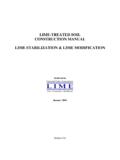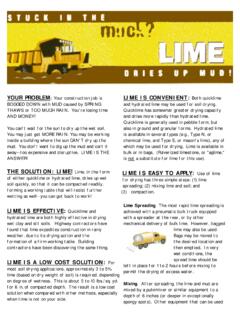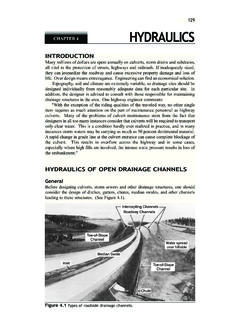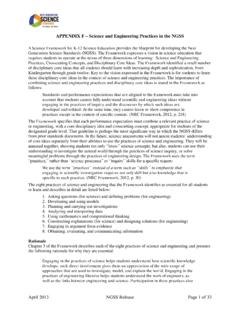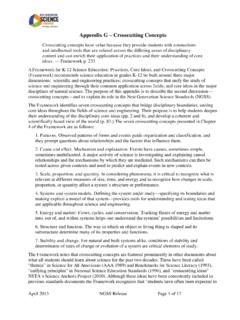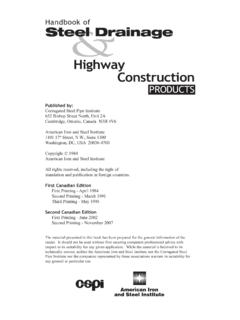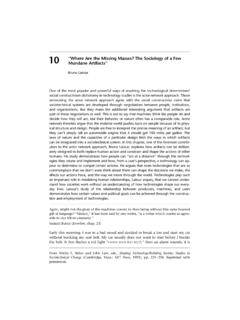Transcription of Lime Treated Soil Construction Manual | Lime Stabilization ...
1 LIME- Treated soil Construction Manual LIME Stabilization & LIME MODIFICATION Published by January 2004 Bulletin 326 Foreword This Manual is written for Construction contractors developing project bids, planning jobs, and conducting Construction activities; for engineers preparing lime Stabilization Construction specifications; for project inspectors; and for civil engineering students. This publication was originally written by the American Road Builders Association Subcommittee on Lime Stabilization and published in 1959 as ARBA Technical Bulletin 243. The National Lime Association assumed publication rights in 1965.
2 This eleventh edition was significantly revised in 2003. About 90,000 copies of previous editions of this Manual have been distributed. Disclaimer: This document is for general guidance and reference purposes only. It is intended for use by professional personnel competent to evaluate the significance and limitations of the information provided and who will accept full responsibility for the application of this information. This document does not supersede or modify any legal requirements, and it is not a binding standard or specification. No liability of any kind is created or assumed by the National Lime Association or its members arising out of any use of it.
3 The National Lime Association does not intend to infringe on any patent or other intellectual property right or induce any other party to do so, and thus users of this document are responsible for determining whether any method, technique, or technology described herein is protected by patent or other legal restriction. Page 2 Table of Contents chapter I: What is Lime?
4 5 Lime Stabilization of Lime Modification & soil The Chemistry of Lime Lime-Pozzolan Mixtures for Soils with Low Amounts of chapter II: OVERVIEW AND COMPARISON OF Construction Construction Advantages and Disadvantages of Different Lime chapter III: DETAILED DESCRIPTION OF Construction Subgrade (or Subbase) 1. Scarification and Initial 2. Lime 3. Preliminary Mixing and 4. Mellowing 5. Final Mixing and 6. 7. Final Base Full Depth Aggregate Base Course Central Lime for Drying & chapter IV: ADDITIONAL Maintaining 27 Need for Wearing Climatic Freezing Early Spring Construction Rain Not Lime Safety Worker Product First Dry Lime Bulk Use of Other Stabilizers with Base Lime-Fly Ash or Lime Kiln Dust Subgrade chapter V: NON-HIGHWAY Embankment Appendix A: Appendix B: NLA soil Stabilization Appendix C: Plasticity Index (PI).
5 39 Appendix D: Charts (converting percent to weight & bag spacing)..40 Page 3 chapter I: INTRODUCTION The long-term performance of any Construction project depends on the soundness of the underlying soils. Unstable soils can create significant problems for pavements or structures (Figure 1).
6 With proper design and Construction techniques, lime treatment chemically transforms unstable soils into usable materials (Figure 2). Indeed, the structural strength of lime-stabilized soils can be factored into pavement designs. Figure 1: Extreme example of pavement failure from unstable soils Figure 2: Comparing untreated plastic clay to lime- Treated clay after initial mixing and mellowing Page 4 Lime can be used to treat soils to varying degrees, depending upon the objective.
7 The least amount of treatment is used to dry and temporarily modify soils. Such treatment produces a working platform for Construction or temporary roads. A greater degree of treatment--supported by testing, design, and proper Construction techniques--produces permanent structural Stabilization of soils. Before beginning any Construction project, project plans and specifications must be developed. For highway pavements, the design must accommodate expected traffic volumes along with environmental, site, and material conditions. All structural designs should be based upon laboratory tests and mix designs that fit the demands of the particular project and provide the most economical alternative for the planned use.
8 This Manual focuses on the subsequent Construction aspects of treating soils with lime. The testing and design of stabilized soil layers is addressed elsewhere. For example, see the mix design and testing protocol at . This Manual was originally written for highway pavement applications, and this revised edition maintains that focus because most lime for soil treatment is used in highway Construction . However, the use of lime for soil drying, temporary modification, and permanent Stabilization is not limited to highway Construction --see chapter V for more information. What is Lime? Lime in the form of quicklime (calcium oxide CaO), hydrated lime (calcium hydroxide Ca[OH]2), or lime slurry1 can be used to treat soils.
9 Quicklime is manufactured by chemically transforming calcium carbonate (limestone CaCO3) into calcium oxide. Hydrated lime is created when quicklime chemically reacts with water. It is hydrated lime that reacts with clay particles and permanently transforms them into a strong cementitious matrix. Most lime used for soil treatment is high calcium lime, which contains no more than 5 percent magnesium oxide or hydroxide. On some occasions, however, "dolomitic" lime is used. Dolomitic lime contains 35 to 46 percent magnesium oxide or hydroxide. Dolomitic lime can perform well in soil Stabilization , although the magnesium fraction reacts more slowly than the calcium fraction.
10 Sometimes the term lime is used to describe agricultural lime which is generally finely ground limestone, a useful soil amendment but not chemically active enough to lead to soil Stabilization . Lime is also sometimes used to describe byproducts of the lime manufacturing process (such as lime kiln dust), which, although they contain some reactive lime, generally have only a fraction of the oxide or hydroxide content of the manufactured product. In this Manual , lime means quicklime, hydrated lime, or hydrated lime slurry. 1 Lime slurry, a suspension of hydrated lime in water, can be made from either hydrated lime or quicklime.




